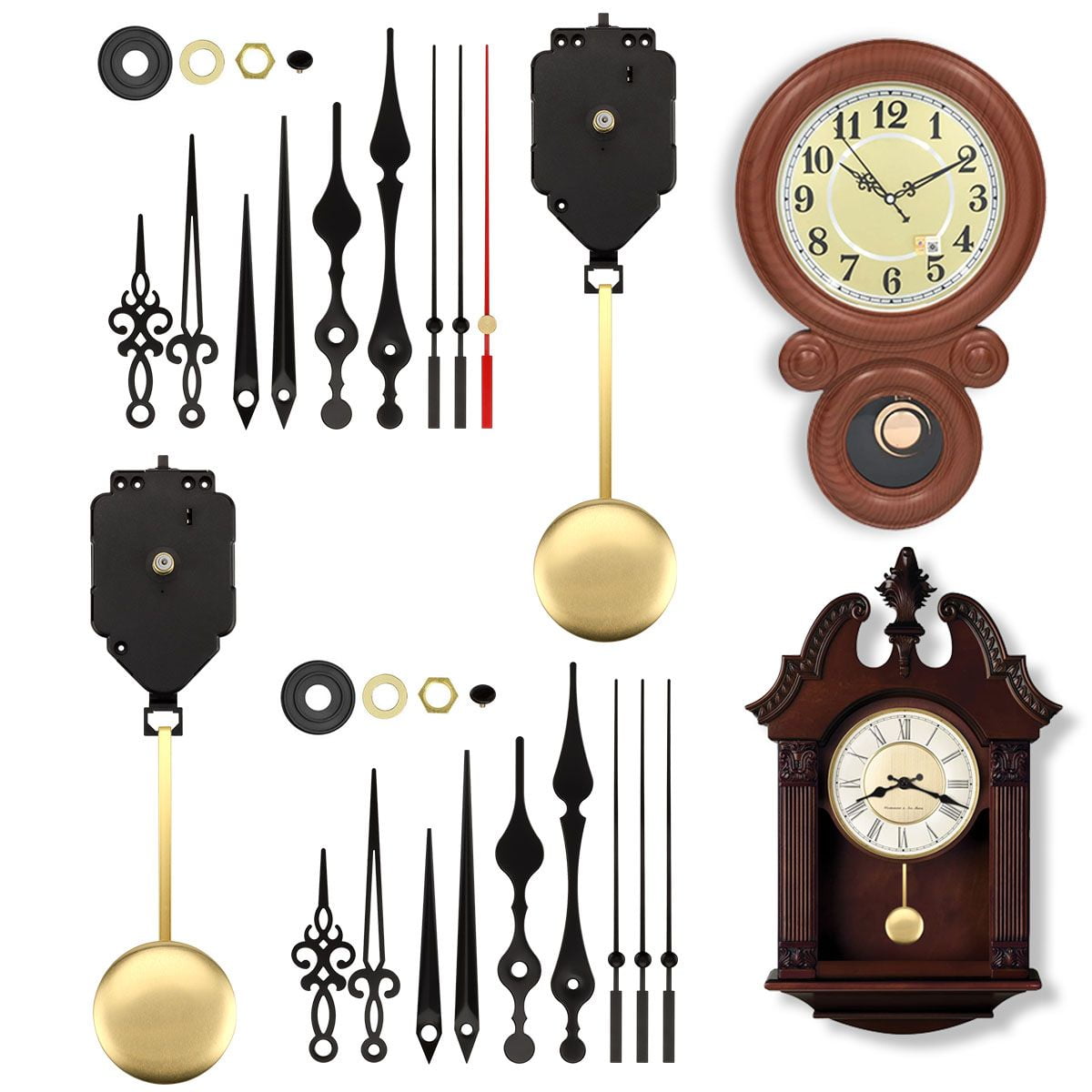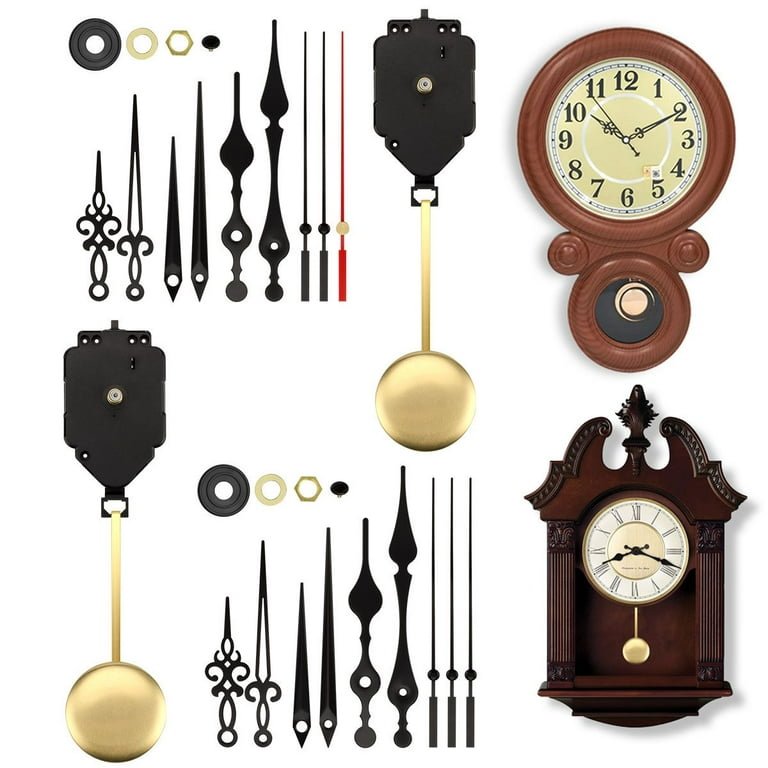To fix a battery-operated pendulum wall clock, replace the batteries and ensure the pendulum is properly attached. If issues persist, check the clock’s internal mechanism for obstructions.
Battery-operated pendulum wall clocks are popular for their classic look and reliable timekeeping. These clocks combine traditional design with modern convenience, requiring minimal maintenance. Sometimes, they may stop working or lose accuracy due to battery or mechanical issues. Addressing these problems can be straightforward if you know where to start.
This guide offers simple steps to troubleshoot and fix your clock, ensuring it remains a charming and functional part of your home decor. With a few basic tools and some patience, you can restore your clock to perfect working condition.

Credit: www.amazon.com
Tools And Materials Needed
Fixing a battery-operated pendulum wall clock requires specific tools and materials. Proper preparation ensures a smooth and successful repair process. Below are the essential tools and a materials checklist for this task.
Essential Tools
- Small Screwdriver Set: Necessary for opening the clock casing.
- Needle-Nose Pliers: Useful for handling small clock parts.
- Soft Cloth: Protects the clock surface from scratches.
- Multimeter: Checks the battery voltage and connections.
- Magnifying Glass: Helps inspect tiny components closely.
Materials Checklist
| Material | Purpose |
|---|---|
| New Batteries | Replace old or drained batteries. |
| Clock Oil | Lubricate moving parts for smooth operation. |
| Cleaning Solution | Clean the clock mechanism. |
| Soft Brush | Remove dust and debris from clock parts. |
| Replacement Parts | Replace broken or worn-out components. |
Initial Inspection
Fixing a battery-operated pendulum wall clock starts with an initial inspection. This step helps identify problems that might be causing the clock to malfunction. A thorough check can save time and pinpoint the exact issue.
Examining The Clock
Begin by examining the clock’s exterior. Look for any visible damage or dust. Make sure the clock is hung properly on the wall. Check if the pendulum is swinging freely without obstruction.
Next, remove the clock from the wall. Inspect the back panel and battery compartment. Make sure the battery is seated correctly and there is no corrosion. Clean any dirt or debris around the battery area.
Identifying Common Issues
Common issues with battery-operated pendulum wall clocks include:
- Dead or weak battery: Replace the battery with a new one.
- Pendulum not swinging: Ensure the pendulum is attached correctly.
- Loose hands: Tighten the hands if they wobble or touch each other.
- Blocked gears: Clean any dust or dirt from the gears.
Use this table to summarize common issues and their solutions:
| Issue | Solution |
|---|---|
| Dead or weak battery | Replace the battery with a fresh one. |
| Pendulum not swinging | Check the pendulum attachment. |
| Loose hands | Tighten the clock hands. |
| Blocked gears | Clean the gears to remove obstructions. |
Removing The Clock Movement
Removing the clock movement is an important step in fixing a battery-operated pendulum wall clock. This task requires careful attention to detail. Below, you will find a guide to safely remove the clock movement.
Safety Precautions
- Turn off the clock and remove the battery.
- Wear gloves to protect your hands.
- Use a clean workspace to avoid losing small parts.
- Keep tools like screwdrivers and pliers nearby.
Step-by-step Removal
- Remove the clock from the wall and place it on a flat surface.
- Detach the pendulum gently to avoid damage.
- Unscrew the back cover using a small screwdriver.
- Locate the clock movement at the center of the back panel.
- Loosen the screws holding the movement in place.
- Carefully pull out the clock movement without forcing it.
Removing the clock movement is now complete. You can proceed with fixing or replacing it.
Replacing The Battery
Replacing the battery in a battery-operated pendulum wall clock is simple. This can restore its functionality and keep it ticking. Follow these steps to ensure your clock runs smoothly.
Choosing The Right Battery
First, identify the type of battery your clock needs. Most clocks use AA or AAA batteries. Check the back of the clock or its manual to confirm. Using the wrong battery can damage the clock. Always use fresh, high-quality batteries.
| Battery Type | Common Clocks |
|---|---|
| AA | Wall Clocks, Pendulum Clocks |
| AAA | Smaller Clocks, Travel Clocks |
Proper Installation
- Locate the battery compartment on the back of the clock.
- Open the compartment by sliding or lifting the cover.
- Remove the old battery carefully. Dispose of it properly.
- Insert the new battery. Ensure the positive and negative ends match the markings.
- Close the battery compartment securely.
After installing the new battery, check if the clock starts ticking. If not, recheck the installation. Make sure the battery is seated correctly. Also, inspect the battery contacts for corrosion. Clean them if necessary.
- Tip: Use a soft cloth to clean battery contacts.
- Warning: Do not use old or damaged batteries.
Cleaning The Clock Mechanism
Cleaning the clock mechanism is an essential step. It ensures your battery-operated pendulum wall clock runs smoothly. Dust and grime can affect the clock’s accuracy. Regular cleaning helps in maintaining its performance and longevity.
Cleaning Materials
Gather the necessary materials before you start the cleaning process. You will need:
- Soft cloth
- Q-tips
- Isopropyl alcohol
- Small brush
- Compressed air can
Make sure these materials are clean and dry. This will help in effective cleaning without causing damage.
Cleaning Process
- Remove the clock from the wall. Place it on a flat surface.
- Open the back cover to access the mechanism.
- Use the soft cloth to wipe off loose dust.
- Dip a Q-tip in isopropyl alcohol. Gently clean the gears.
- Use the small brush to reach tight spots.
- Blow out any remaining dust with the compressed air can.
- Ensure all parts are dry before reassembling the clock.
Cleaning the clock mechanism regularly keeps it in good condition. It ensures accurate timekeeping and prolongs the clock’s life.
Reassembling The Clock
Reassembling the clock is a crucial step in fixing a battery-operated pendulum wall clock. Proper reassembly ensures the clock functions correctly and maintains its aesthetic appeal. Follow these steps to reattach the movement and ensure proper alignment.
Reattaching The Movement
Start by reattaching the clock movement to the back of the clock face. Align the movement’s shaft with the center hole on the clock face.
- Insert the shaft through the center hole.
- Secure the movement with the provided screws or clips.
- Ensure the movement is firmly attached and does not wobble.
Ensuring Proper Alignment
Proper alignment of the clock’s hands is essential for accurate timekeeping. Follow these steps to ensure everything is correctly aligned:
- Place the hour hand on the movement’s shaft first. Push it gently until it is snug.
- Next, attach the minute hand in the same manner.
- Finally, secure the second hand if your clock has one.
Make sure all hands move freely and do not touch each other. To test, set the time and observe the movement. The pendulum should swing smoothly and the hands should rotate without obstruction.
Below is a quick reference table to check your reassembly progress:
| Step | Action | Check |
|---|---|---|
| 1 | Reattach Movement | Firmly Attached |
| 2 | Align Hour Hand | Snug Fit |
| 3 | Align Minute Hand | Snug Fit |
| 4 | Align Second Hand | Free Movement |
| 5 | Check Pendulum | Smooth Swing |
By following these steps, your pendulum wall clock should be reassembled correctly. Enjoy your functioning clock!
Testing The Clock
Testing your battery-operated pendulum wall clock is crucial. This ensures it functions correctly and helps identify any issues early. Let’s dive into the steps to test your clock effectively.
Initial Testing
Begin by checking the battery. Remove the back cover of your clock. Ensure the battery is placed correctly. Use a new battery for the best results.
Next, set the time on your clock. Observe the movement of the hands. Ensure they move smoothly without any jerks. Check the pendulum. It should swing evenly without stopping.
Here’s a quick checklist for initial testing:
- Check battery placement
- Use a new battery
- Set the correct time
- Observe the hand movements
- Ensure the pendulum swings evenly
Troubleshooting Tips
If your clock isn’t working correctly, follow these troubleshooting tips. First, check if the battery is new. Old batteries may not provide enough power.
Ensure the battery contacts are clean. Dust or corrosion can prevent proper connections. Use a soft cloth to clean them.
Check the hands of the clock. If they are touching, they may stop the clock. Gently adjust them to ensure they don’t touch each other.
Sometimes, the pendulum may not swing. Ensure it is properly attached. Adjust its position if needed.
Here’s a quick troubleshooting table for easy reference:
| Problem | Solution |
|---|---|
| Clock not working | Check and replace the battery |
| Hands not moving | Ensure hands do not touch each other |
| Pendulum not swinging | Check and adjust the pendulum |
| Corroded battery contacts | Clean contacts with a soft cloth |

Credit: www.amazon.com
Maintaining Your Clock
Proper maintenance of your battery-operated pendulum wall clock ensures it runs smoothly. Regular care can extend its life and keep it accurate. Follow these tips to maintain your clock effectively.
Regular Maintenance Tips
- Clean the Clock: Dust can affect the clock’s mechanics. Use a soft, dry cloth to clean the exterior and interior parts.
- Check the Battery: Replace the battery every six to twelve months. Use high-quality batteries to ensure the clock runs smoothly.
- Lubricate Moving Parts: Apply a small amount of clock oil to the moving parts. This reduces friction and wear.
- Inspect the Pendulum: Ensure the pendulum moves freely. Adjust it if it’s rubbing against the clock case.
When To Seek Professional Help
- Clock Stops Working: If the clock stops despite a new battery, seek professional assistance.
- Strange Noises: Unusual sounds from the clock may indicate mechanical issues. A clock repair expert can diagnose and fix the problem.
- Broken Parts: If any parts break, contact a professional. They can replace parts and restore the clock’s functionality.

Credit: www.walmart.com
Frequently Asked Questions
Why Is The Pendulum Not Working On My Battery Operated Clock?
The pendulum might not be working due to a dead battery, misalignment, or mechanical issues. Check and replace the battery first. Ensure the pendulum is correctly positioned. If the problem persists, inspect the clock’s internal mechanism for any faults.
Why Is My Battery Operated Clock Not Working?
Your battery-operated clock may not work due to dead batteries, loose connections, or internal mechanism issues. Replace batteries first.
Why Has My Pendulum Clock Stopped Working?
Your pendulum clock may have stopped due to power loss, misaligned gears, a broken pendulum, or dust buildup.
What Makes Pendulum Swing On A Battery Operated Clock?
A battery-operated clock uses an electromagnet to swing the pendulum. The battery powers the electromagnet, creating periodic pulses. These pulses attract a metal piece on the pendulum, causing it to swing back and forth. This motion helps regulate the clock’s timekeeping mechanism.
Conclusion
Fixing a battery-operated pendulum wall clock is simple with the right steps. Regular maintenance ensures accurate timekeeping. Always handle delicate parts carefully. Enjoy your clock’s reliable performance by following these tips. Keep your timepiece in top condition with periodic checks and timely battery replacements.
Happy clock fixing!

